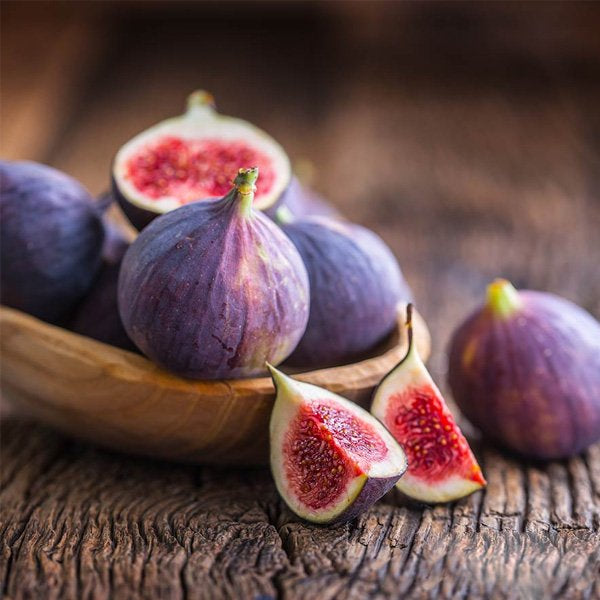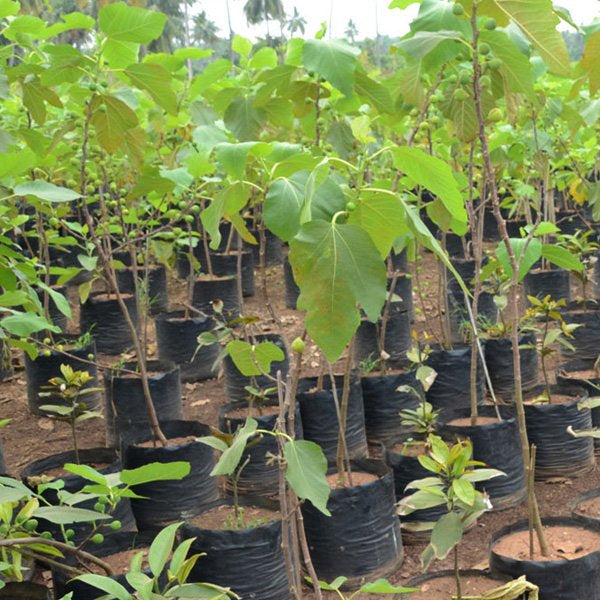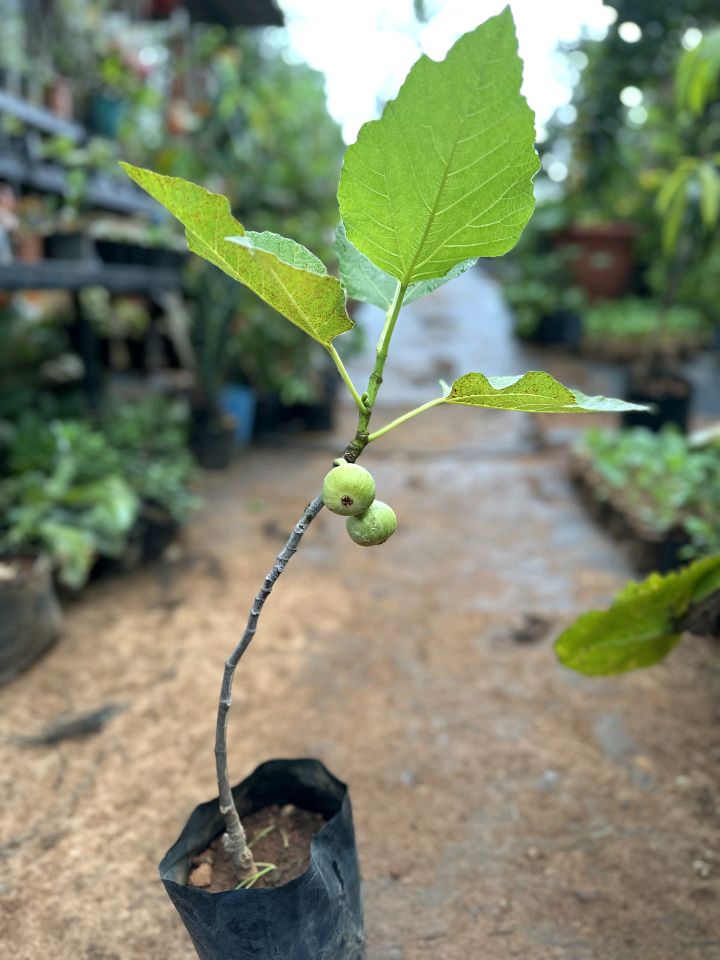MR
Israel Fig / Anjeer / Athi pazham Grafted Live Plant
Israel Fig / Anjeer / Athi pazham Grafted Live Plant
Couldn't load pickup availability
Bring home the richness of ancient nutrition with the Israel Fig (Anjeer/Athi Pazham) — a highly cherished fruit known for its sweetness, health benefits, and rich history. This grafted variety of Ficus carica is fast-growing, low-maintenance, and perfectly suited for Indian weather. In addition to providing fresh, nutrient-rich Anjeer fruits, this versatile plant adds charm to your garden with its large ornamental leaves and soft, woody texture.
| Plant Type | Grafted Plant |
| Family | Moraceae |
| Common Names | Fig, Anjeer, Athi Pazham |
| Botanical Name | Ficus carica |
| Sapling Age | 1 Year |
| Fruit Taste | Sweet |
| Bloom Time/Fruiting | 1 month |
| Ideal Temperature | 15°C to 35°C (warm and humid climate, can withstand mild frost) |
| Health Benefits |
|
| Sunlight | Full to partial sunlight |
| Fruiting Frequency | Throughout the year |
| Plant Height | 2 feet |
| Lifespan | Perennial |
| Maintenance Required | Easy |
🌳 Why Grow This Anjeer Plant?
Naturally Sweet & Nutrient-Dense Fruit
Each fig is packed with fibre, calcium, potassium, and antioxidants—great for digestion, heart health, and bone strength.
Fast Growing & Grafted for Better Yield
This grafted fig plant grows quickly, gives fruits faster, and suits Indian weather well, making it easy to get a good harvest at home.
Long Lifespan
This is a perennial plant, offering years of fruit and shade with minimal care.
🍀Plant Features – Israel Fig / Anjeer / Athi Pazham
🍈 Fruit – Sweet, Nutritious & Unique
The Israel fig fruit is soft, sweet, and filled with tiny crunchy seeds. Ripe figs are tear-shaped, about 3–5 cm in size, and change from green to purple or brown when ready. Inside, the reddish-pink flesh is rich in fiber, vitamins A, C, and K, and minerals like calcium and potassium. You can eat them fresh, dried, or use them in jams, snacks, and desserts.
🍃 Leaf – Large, Fragrant & Lush
The fig plant has large, dark green leaves with 3 to 5 lobes. These leaves are leathery, grow up to 45 cm long, and have a wavy edge. When crushed, they release a pleasant smell like coconut, vanilla, and green walnut. Apart from their beauty, fig leaves are known in traditional medicine for helping manage cholesterol and blood sugar.
🌸 Flower – Hidden Beauty
The fig flower is not seen outside—it grows inside the fruit structure known as the syconium. These tiny internal flowers develop into seeds and pulp after pollination. Though hidden, they are important for making the delicious fig fruit. In fact, the fig is actually an upside-down flower, which makes it a unique plant in nature.
🌲 Plant Growth & Habit
This is a deciduous shrub or small tree that grows with a wide, rounded shape. In the ground, it can reach up to 10–12 feet in height, and in pots, about 6–8 feet. The plant grows well in pots, grow bags, or directly in the garden—ideal for terraces, balconies, or backyard gardens.
🌱 Plant Care Guide
☀️ Sunlight
Fig trees love the sun! To grow healthy and produce plenty of sweet anjeer fruits, make sure your fig plant gets at least 5 to 6 hours of direct sunlight every day. It thrives best in full sun but can also manage partial shade. A sunny balcony, terrace, or open garden space is ideal. Without enough sunlight, the plant may grow slowly and produce fewer or less sweet fruits.
🌡️ Temperature
Perfectly suited for Indian climates, fig trees grow well in temperatures between 15°C to 35°C. They can handle warm weather, but when temperatures exceed 40°C, fruit quality may reduce. In cooler regions, mature fig plants tolerate mild frost (down to 4°C), while young plants require protection.
🌱 Soil
Figs thrive in well-drained, slightly acidic to neutral soil (pH 6–7) enriched with organic matter such as compost or cow dung. The ideal soil type is loamy or clay-loam, which retains moisture without becoming soggy. Proper drainage is essential, as waterlogged soil can cause root rot. For pot cultivation, use a nutrient-rich potting soil to support healthy growth.
💧 Watering
Water deeply and consistently, especially during the summer heat. Allow the top 1–2 inches of soil to dry before watering again. In pots, fig plants may need water daily in hot weather. Too little water causes drooping leaves; too much causes yellowing and root rot. Waterlogging will kill the plant, so always ensure good drainage. During the rainy season, reduce watering to avoid over-saturation. Morning watering is best to keep roots hydrated and leaves dry.
🪴 Container Size
For terrace or balcony gardening, start your fig plant in a 25-inch pot or 24x24 inch grow bag. A spacious container encourages stronger roots and better fruiting. Always choose a pot with multiple drainage holes to prevent waterlogging.
🌿 Fertiliser
Feed your fig plant with organic fertiliser every 4–6 weeks during the growing season (spring to early autumn). Use well-rotted goat dung, bone meal, seaweed extract, fish amino acid, or compost. These help boost fruit production and leaf growth. Avoid over-fertilising—it can lead to too much leafy growth and less fruit. Stop fertilising in winter when the plant goes dormant.
🐛 Pest & Disease Management
Watch out for mealybugs, fig beetles, spider mites, and scales. Spray neem oil or bio-insecticide once a week as a preventive measure. For minor infestations, a strong jet of water can remove pests. Regularly inspect the underside of leaves and branches. Remove any infected or curled leaves to keep the plant healthy.
✂️ Pruning
Prune your fig plant in late February to early March before new growth begins. Trim dead, diseased, or crossing branches to encourage airflow and sunlight. This not only shapes the tree but boosts fruit production. Summer pruning can also control height. Avoid heavy pruning as figs fruit on new wood—light shaping is best for steady yields.
🍂 Mulching
Apply a 2–3 inch layer of organic mulch (like straw, dry leaves, or cocopeat) around the base of the plant. Keep it a few inches away from the trunk. Mulching helps retain moisture, control weeds, and regulate soil temperature. In colder regions, mulch also protects roots from winter chill. It’s especially useful for in-ground plants and large container setups.
🍈Harvesting & Fruit Facts:
When to Harvest:
Look for soft, drooping fruits with slight neck wilting. Ripe figs are fragrant, juicy, and rich in flavour.
Fruit Weight:
Each fig weighs about 40–50 grams, with larger fruits in early harvests.
Harvest Season in India:
From February to May or June. Figs don’t ripen after picking—so pick only when ripe!
Storage Tips:
Eat fresh, refrigerate for 2–3 days, or freeze/dry for long-term use.
🌾Health & Nutrition Benefits of Anjeer Fruit:
Rich in Fiber – Boosts digestion, helps relieve constipation
Heart Healthy – May lower bad cholesterol and improve blood circulation
Bone Strength – Contains calcium and potassium for strong bones
Weight-Friendly – Keeps you full longer, supports metabolism
Ayurvedic Value – Used traditionally to treat diabetes, skin issues, and improve immunity
Antioxidant-Rich – Protects against free radicals and inflammation
Note: There are quite a few processes and steps to be done by us to make sure the plants are shipped very safely. Hence please allow us 5-7 business days for processing and shipping your orders. Orders are usually shipped on Mondays and Tuesdays to ensure that the shipments are not held up during weekends.
Plants if damaged while transit will be replaced free of cost. We will need uncut unboxing video for processing the replacement
IMPORTANT NOTE: Please don't repot or re-plant the plants immediately after receiving it. Keep it in the same bag that you receive and water regularly for 2 weeks. You can then repot them to bigger container, grow bags or your field.
Share





